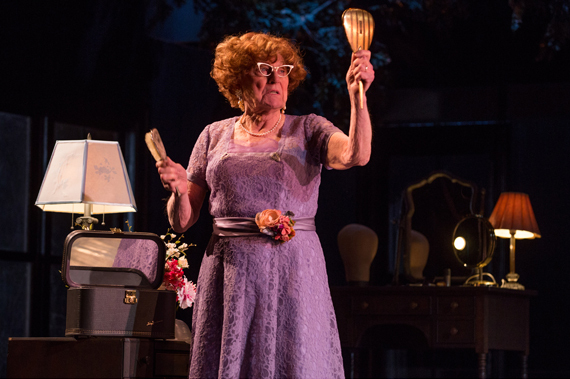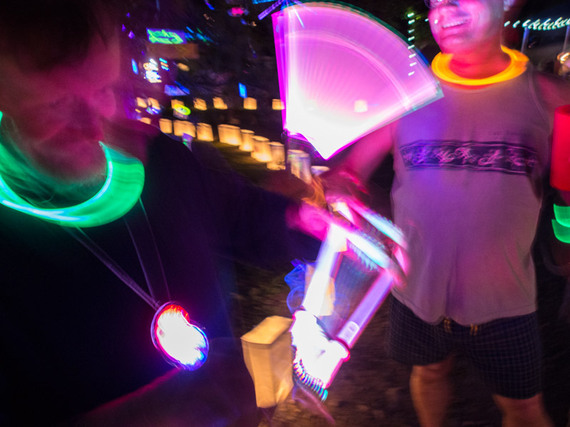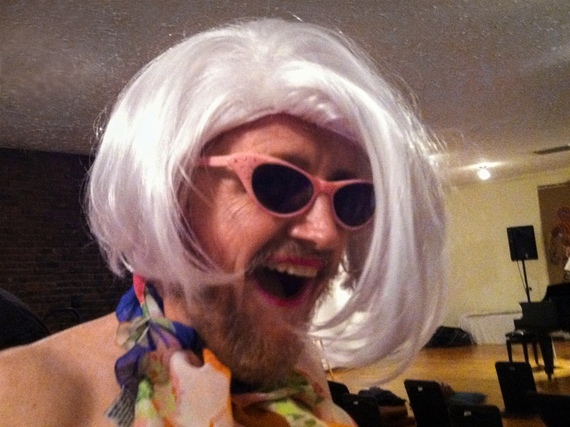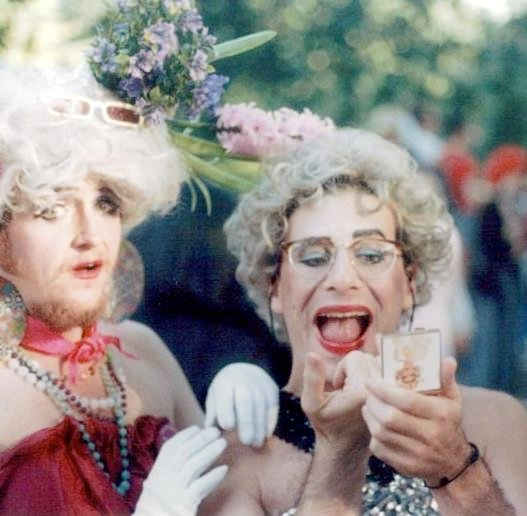You may know the safety of family, trustworthy friends, even colleagues and clients, who manage -- sometimes to our astonishment -- to celebrate (or tolerate) our eccentricities. But for so many others, as with the mostly heterosexual transvestites in Casa Valentina, Fierstein's new, often uproarious drama, dearly held passions are closeted and can only find expression in a perceived environment of shared interests.
Fierstein's work is set in 1962, based on the real-life Casa Susanna. But a quick glimpse of Meetups confirms how socially important spending time with like-minded people still is. Even though most of us at some point know the hurt of feeling like an outsider, we're also privy to how powerful and beneficial this tribal bonding can be.
In the early 1980s, an editor at Christopher Street Magazine somehow got me in (eschewing the many hundreds of dollars "tuition") for an 'est Training', which reputedly catalyzed 'profound transformation', but which also had people fussing over bathroom breaks and insults hurtled at them by training leaders.
I was to write a scathing review about 'est-holes,' but instead observed how many people were decked, startled and revitalized by what felt to me like dopy sensory explorations similar to those i recalled from a freshmen year acting class. But for many of them around me, this weekend of peeling cherry tomatoes and 'getting it' appeared to genuinely be a useful catalyst for some growth.
Then, eight years ago when a relationship drizzled out after more than two decades, I found myself for the first time wondering how to connect meaningfully to other gay men. And a good friend urged me to go camping in the Poconos.
Fierstein's play is set in an old lodge in the Catskills, owned by a cross-dressing husband and his wife, who both warmly welcome the guests as very much family.
Upon my arrival at The Woods Campground, I timidly parked the car and smiled goofily as several cheerful wiener-wagging nudists welcomed me. In the reception, with bug spray, sun screen and condoms on the counter, the owner's 40-sumpthin' sister was genuinely curious about what it's like to live in Crazy New York, then tipped me not to skip the nude bingo before the campfire that eve. Unlike the cold pose-or-be-posed environment of most bars, open, playful, flirty and warm interactions of almost every single person at the campground left me flabbergasted. Maybe these (mostly rural) people were just more "friendly" than New Yorkers?
Like the lonely hearts on stage in Casa Valentina, i was overwhelmed with joy to feel embraced by this community, a spectrum of ages (and unlike the Casa, the Woods welcomed all races). I've often explained to friends visiting New York who are disappointed by the intense homogeneity of NYC gay venues that NYC is about real estate -- and we are but target markets to highly-specific demographics (including class, education, race and age).
In Casa Valentina, merciless social oppression is the original driving force for the cloistered kibbutz, not country-club-like gates, where people are selectively excluded. But both dynamics remain, in varying degrees, and can be a factor in many communities; from faith-based camps, women's music festivals and even delirious celebrity fan-bases.
All over the campground, people were busily and generously helping each other to construct glowing sculptures in anticipation of a jet-black night in the forest -- a sort of a mini- Burning Man weekend, with as many brilliant and innovative ideas as seen during a Saturday stroll through Chelsea galleries.
And that generosity of spirit, playfulness and camaraderie moved me to tears -- as did observing joyful new friendships sprouting up beyond any rote sexual hookup.
Several years ago, my then new partner (we met at still another tribal corral called 'bear411.com') invited me for an "empowerment weekend" at Easton Mountain, a retreat for gay men near Albany, NY. I came along, reluctantly. Like at EST, I saw very simple rituals (..."Second week, more advanced, and we had to Be a table, be a sportscar... Ice-cream cone"...) and saw them really move some of the guys. But I also got to see an aspect that made Fierstein's work so deeply moving.
In a particularly expressive moment, the great actor John Cullum sits, ever so gently reaching out with matronly calm toward one of 'her' 'fellow' kindred spirits. On the second day of the Easton Mountain retreat, two local gay activists (and I call them that in the most honorable way possible) spent an entire morning UNLOADING A TRAILER TRUCK FILLED WITH HAND-PICKED WOMEN'S CLOTHES AND ACCESSORIES into a small building used as a sanctuary on the grounds.
We were invited to enter and explore, then be styled for a fashion review that evening. This was no biggy for me: I've styled friends for Wigstock and drag marches, i've aspired to be a radical faerie. I grabbed a white bob wig, wore it sideways; pulled a multi-layerd long black tulle skirt over my chest, turning it into a full, hilarious and cute mini. Cat glasses, Pantone 32 red lipstick -- and became Tiffany Wallmart.
But for other men my age, the exploration into the wardrobe was uncharted territory. One man was a cheerful 'guys guy,' a sports coach from a small town. Overwhelmed in the clothes racks, he confided in me that he had "often" thought about how he'd look as a woman. And he ended up looking pretty dowdy, in a full-fitted silver evening dress (that Margaret Rutherford might have rejected), silver-blonde wig, too-large broach and matching matronly hat. Once in makeup, he was visibly shaken -- as, in Fierstein's tale, was the newbie (in a tour de force by Gabriel Ebert). The coach stayed in his new persona throughout the evening, demurely eating and softening his voice when he spoke.
Stanislavski says actors build the character from the soles up, and the coach's modest high heels informed his every breath.
A couple of years ago for my birthday, I invited a handful of friends -- and their teens -- to join me at another such safe haven, the Big Apple Ranch, an incredibly sweet-spirited weekly get-together at a dance school in Chelsea. Evenings feature an hour of tutoring on two-step, line dancing and Texas Swing. The community is tight-knit but welcomed my puzzled straight (and puzzled gay) friends -- though one friend took the invite a bit too seriously and encouraged her Bruce Willis doppelganger fireman husband to dress for the event. And he did so, too earnestly, right down to the spurs -- and was met by a room full of adoring (okay, there was some swooning) gays, and respectful lesbians. And remarkably, he, of all people, felt safe.
While respecting the narrative arc of Fiersteins' work, he confirms universal truths about the duration of trust and inevitability of change. Even for those of us who are cultural interlopers at such sanctuaries -- minus the environments that cultivate additions and cruelty as their norm -- we must be happy for surrogacies that nurture any sense of self and community.
If you are lucky enough to find safety in expressing your selves with your immediate family; consider yourself very fortunate. If you find it at a leather bar, church outing or running club, cherish the camaraderie. As the beautiful portrayals in Fierstein's Casa Valentina solemnly show, so many people are not so fortunate, even fleetingly.
This post has been updated from a previously published version.



